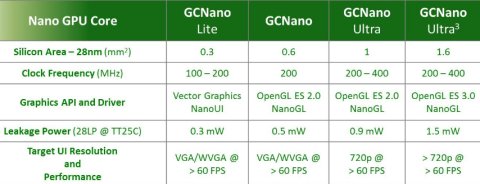Compact GCNano Series for MCU/MPU Composition and UI acceleration in DDR-less and memory-limited configurations, along with the shipping GC7000 Series for OpenGL® ES 3.1*/3.0, rounds out Vivante’s full line of wearables/IoT GPUs
San Francisco, CA – June 2, 2014 – Design Automation Conference (#51DAC) – Vivante Corporation today announced the immediate availability of the GCNano Series, the latest product offering to complete its wearables and IoT GPU line. The series includes the GCNano Lite, GCNano and GCNano Ultra, all architected for various wearable and IoT segments supporting the upcoming generation of customized MCU/MPU platforms that demand the most compact UI graphics hardware and software footprint. All products are optimized for MCU/MPU solutions with limited CPU resources, limited memory resources and long battery life, but extend support to include tightly coupled integration with the display controller, no-OS / no-DDR configurations (GCNano Lite) and custom / full OS with minimal DDR memory for solutions that need OpenGL® ES 2.0 (GCNano and GCNano Ultra). The cutting-edge GCNano optimizes PPA and software efficiency to improve overall device performance and BOM cost, while extending battery life from days/weeks between charges without restricting the onscreen user experience.

As part of the launch, Vivante’s software driver stack, SDK and toolkit will support its NanoUI API that brings close-to-the-metal GPU acceleration for no-OS / no-DDR options on GCNano Lite and the NanoGL API for more advanced solutions that include proprietary or high-level operating systems like embedded Linux, Tizen™, Android™, Android™ Wear and other RTOS that require OpenGL ES 2.0 in the smallest memory footprint. These various OS / non-OS platforms will form the base of next generation wearables and IoT that bring personalized, unique and optimized experiences to each person. The GCNano drivers include aggressive power savings, intelligent composition and rendering, and bandwidth modulation that allow OEMs and developers to build rich visual experiences on wearables and IoT using an ultralight UI / composition driver.
“Wearables and IoT will create a new way of accessing, analyzing and displaying data much like the smartphone has changed the way we access information. To create compelling wearables and IoT products that meet user demand for intuitive UIs, size, weight and power, the industry has expanded to include application specific MCU/MPU hardware to enable a new category of products. Graphical UIs are a key driver in product adoption and traditional MCU/MPU platforms have historically focused on simple UI displays, which fragment those products from typical consumer devices,” said Wei-jin Dai, President and CEO of Vivante. “To solve this problem we developed the GCNano Series with careful attention to the ultra-fine details like silicon size, low power, memory footprint, driver size, bandwidth reduction and display controller / UI pairing, minimal CPU overhead and image quality to create an amazing user experience on these new MCUs/MPUs. These leading innovations continue to make our Smaller-Faster-Cooler GPU IP the ‘gold standard’ in PPA and feature robustness in all market segments.”
GCNano Series benefits include:
About Vivante Corporation
Smaller – Faster – Cooler: Vivante Corporation, a leader in multi-core GPU, OpenCL™, CPC Composition Engine and Vector Graphics IP solutions, provides the highest performance and lowest power silicon characteristics across a range of Khronos™ Group API conformant standards based on the Vega architecture. Vivante GPUs are integrated into customer silicon in devices targeting wearables, IoT, smartphones, tablets, HDTVs, consumer electronics and embedded devices and running thousands of graphics/compute applications across multiple operating systems and software platforms. Vivante is a privately held company headquartered in Sunnyvale, California, with additional R&D centers in Shanghai and Chengdu.
*Product is based on a published Khronos OpenGL ES 3.1 Specification, and is expected to pass the Khronos Conformance Testing Process. Current conformance status can be found at www.khronos.org/conformance.